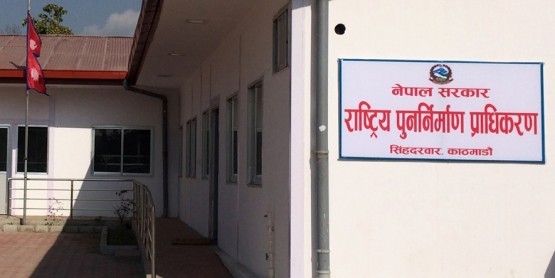NRA rebuilds 83% houses in 4 years

By Modnath Dhakal
Kathmandu, Dec. 27: The National Reconstruction Authority (NRA), a body created for the post-quake rebuilding with a five-year mandate, has started working for its exit strategy.
The reconstruction body was officially launched on December 26, 2015, eight months after a quake of 7.6 on Richter scale devastated the central and eastern hills in the country, killing about 9,000 people and damaging about a million houses, as well as schools, health facilities and infrastructure.
The NRA has only a year to wrap up the work since its five-year tenure is expiring in December next year.
Presenting the achievements of the NRA in the past four years at a press meet on Thursday, its Chief Executive Officer Sushil Gyawali said that about 83 per cent progress was made in the reconstruction of private houses in the 32 quake-hit districts.
“A major part of the reconstruction of private houses, health facilities, offices of the government and security agencies, heritage and local infrastructure has been completed while the remaining are in rebuilding process,” he said.
He maintained that the reconstruction of the private houses would be completed by the end of 2020. The responsibility would be handed over to the local levels in case the works remain incomplete.
The reconstruction body has enhanced cooperation and coordination with the recently formed National Disaster Risk Reduction and Management Authority so that the exercise of the NRA, statistics and organisational memory could be institutionalised.
The NRA has also initiated work to hand over the existing information system to the federal, state and local governments in order to enable the central as well as sub-national governments with reliable and effective disaster information system.
“Risk mapping of each local unit will be done, and it will be used as the foundation in land use planning, periodic planning and house-standards making,” said Gyawali.
The local units’ capacity would be enhanced in terms of implementing national building code to create quake-resilient houses.
Likewise, the remaining responsibility of heritage reconstruction will be given to the Department of Archaeology and respective local bodies. Of the damaged 891 heritages, 387 have been rebuilt and 123 are under construction while the reconstruction of 381 is yet to begin. Monastery rehabilitation is lagging with a handful being reconstructed out of damaged 1320 monasteries.
Similarly, remaining works of rural roads and water supply will come under the responsibility of the local bodies. All the damaged roads and water supply infrastructure are either reconstructed or in the process to be rehabilitated.
Knowledge sharing with int’l community
The NRA is planning for an international conference on the post-quake reconstruction in November next year. The conference will be a platform where Nepal will share the knowledge, skills and learning acquired from the rescue, relief and reconstruction work after the 2015 earthquake.
However, the NRA seconded that it was organising a conference to raise the money unmet amount for the post-quake reconstruction. Gyawali said that various workshops
and symposiums would be
organised throughout the year in 2020 so that the knowledge could be handed over to the future generations.
Reconstruction budget
About Rs. 293 billion has been spent in the post-quake reconstruction in the country in the past four
years. The government has allocated Rs. 141 billion in the current fiscal year 2019/20, but the source of Rs. 34 billion is unknown so far. Ministry of Finance has said that it would manage the missing resources for reconstruction.
Recent News

Do not make expressions casting dout on election: EC
14 Apr, 2022
CM Bhatta says may New Year 2079 BS inspire positive thinking
14 Apr, 2022
Three new cases, 44 recoveries in 24 hours
14 Apr, 2022
689 climbers of 84 teams so far acquire permits for climbing various peaks this spring season
14 Apr, 2022
How the rising cost of living crisis is impacting Nepal
14 Apr, 2022
US military confirms an interstellar meteor collided with Earth
14 Apr, 2022
Valneva Covid vaccine approved for use in UK
14 Apr, 2022
Chair Prachanda highlights need of unity among Maoist, Communist forces
14 Apr, 2022
Ranbir Kapoor and Alia Bhatt: Bollywood toasts star couple on wedding
14 Apr, 2022
President Bhandari confers decorations (Photo Feature)
14 Apr, 2022











